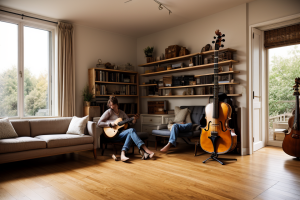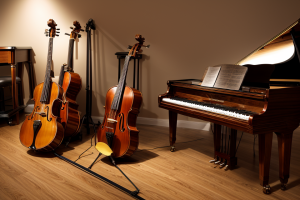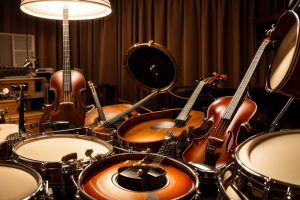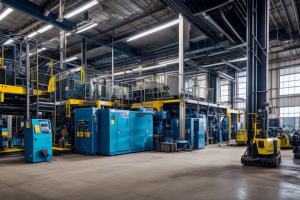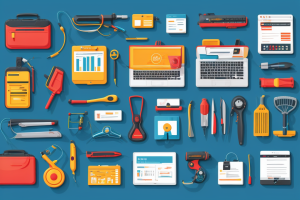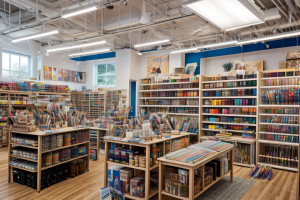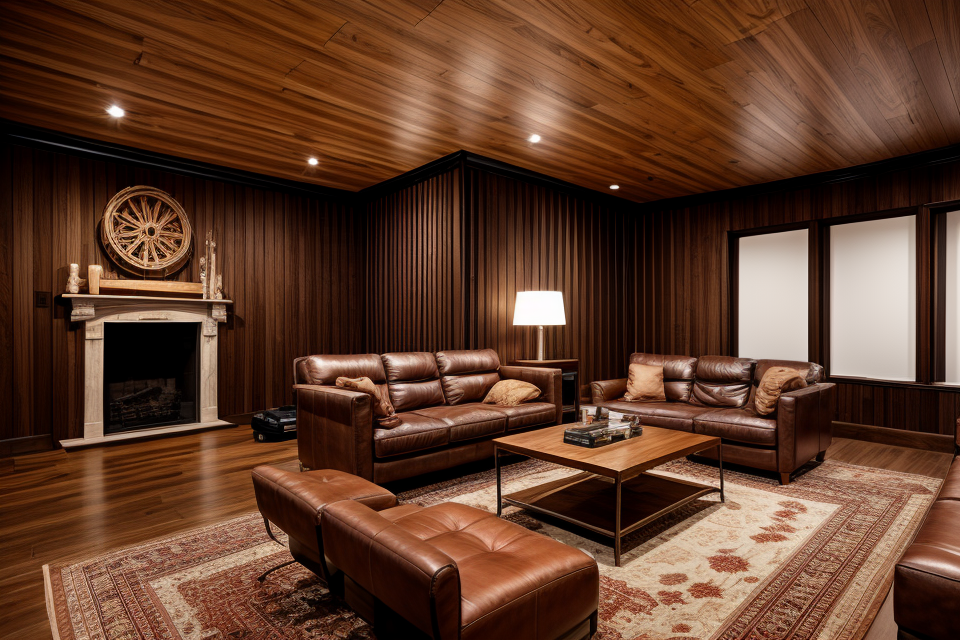
As musicians, we all want to ensure that our instruments are in top condition, and one crucial aspect of instrument care is storage temperature. The wrong temperature can cause damage to your instrument, affecting its sound quality and lifespan. But what is the best temperature to store your musical instruments? In this comprehensive guide, we will explore the optimal storage temperature for various instruments, from stringed instruments like violins and cellos to woodwind and brass instruments. We will also discuss the risks associated with storing instruments in extreme temperatures and humidity levels. So, whether you’re a professional musician or a hobbyist, read on to discover the key to keeping your instruments in top condition.
What Temperature is Ideal for Instrument Storage?
The Importance of Temperature in Instrument Preservation
Maintaining the ideal temperature for musical instrument storage is crucial for preserving their condition and ensuring they remain in top condition for years to come. Extreme temperatures, whether too hot or too cold, can cause damage to the instrument’s components, altering its tuning, and reducing its overall playability. In this section, we will discuss the importance of temperature in instrument preservation and why it is essential to maintain the right temperature for instrument storage.
- Dehumidification: High temperatures can cause the wood in musical instruments to dry out, leading to cracks and warping. On the other hand, low temperatures can cause the wood to shrink and become brittle, which can also result in damage to the instrument. It is essential to maintain a consistent temperature and humidity level to prevent the wood from drying out or becoming too damp.
- Tuning stability: Extreme temperatures can cause the metal components in musical instruments to expand or contract, leading to changes in the instrument’s tuning. Maintaining the right temperature ensures that the instrument stays in tune and is ready to play at all times.
- Preservation of electronic components: Many modern musical instruments have electronic components that can be sensitive to temperature changes. High temperatures can cause electronic components to malfunction, while low temperatures can cause them to become brittle and prone to breaking. It is important to maintain a consistent temperature to ensure that electronic components remain in good working order.
- Protection against damage: Extreme temperatures can cause damage to the instrument’s finish, such as cracking or discoloration. Maintaining the right temperature ensures that the instrument’s finish remains intact and in good condition.
In conclusion, the temperature of the storage environment is crucial for the preservation of musical instruments. It is essential to maintain a consistent temperature and humidity level to prevent damage to the instrument’s components, such as the wood, metal, and electronic components. Maintaining the right temperature also ensures that the instrument stays in tune and is ready to play at all times.
Recommended Temperature Range for Instrument Storage
The recommended temperature range for instrument storage is between 15°C to 21°C (59°F to 70°F). This range has been determined through research and is considered optimal for preserving the condition and longevity of musical instruments. It is important to note that the ideal temperature may vary slightly depending on the specific type of instrument, as well as its material composition and construction.
The recommended temperature range for instrument storage helps to prevent damage from extreme temperatures, such as heat or cold, which can cause warping, cracking, or other structural damage to the instrument. It also helps to protect against humidity and moisture, which can cause corrosion or damage to electronic components.
Additionally, the recommended temperature range is important for maintaining the tuning and overall performance of the instrument. Extreme temperatures can cause the wood to expand or contract, leading to changes in the instrument’s shape and pitch.
It is worth noting that the recommended temperature range may not be practical for all storage environments, especially for those who do not have climate-controlled spaces. In such cases, it is important to take additional measures to protect the instrument, such as using a humidifier or dehumidifier to control the humidity level.
In summary, the recommended temperature range for instrument storage is between 15°C to 21°C (59°F to 70°F). This range helps to protect against damage from extreme temperatures, humidity, and moisture, and helps to maintain the tuning and overall performance of the instrument.
Factors Affecting Instrument Storage Temperature
Proper storage temperature and humidity levels are crucial for preserving the condition and longevity of musical instruments. The recommended temperature range for instrument storage is between 15°C to 21°C (59°F to 70°F). Maintaining the right temperature helps to prevent damage from extreme temperatures, humidity, and moisture, and helps to maintain the tuning and overall performance of the instrument. It is also important to consider factors such as humidity, direct sunlight, and temperature fluctuations when choosing a storage space for your instruments. Proper temperature and humidity control can significantly impact the lifespan and overall performance of your musical instruments.
Humidity
Humidity is another critical factor to consider when determining the optimal storage temperature for musical instruments. High humidity can cause the wood to swell, which can lead to cracks and damage to the instrument. On the other hand, low humidity can cause the wood to dry out, which can also lead to cracks and damage.
It is essential to maintain a consistent humidity level of around 40-60% to prevent damage to the instrument. To achieve this, it is recommended to use a humidifier or dehumidifier to control the humidity level in the storage environment.
It is also important to note that sudden changes in humidity can be particularly damaging to instruments. For example, if an instrument is exposed to high humidity for an extended period and then suddenly exposed to low humidity, it can cause the wood to shrink and crack.
In addition to affecting the wood, humidity can also affect the mechanical components of musical instruments, such as the pads and valves in brass instruments. High humidity can cause these components to swell, which can lead to malfunction and damage.
Overall, controlling the humidity level in the storage environment is crucial to prevent damage to musical instruments. By using a humidifier or dehumidifier and avoiding sudden changes in humidity, instrument owners can ensure that their instruments remain in optimal condition.
Direct Sunlight
Exposure to direct sunlight is one of the most detrimental factors that can negatively impact the storage temperature of musical instruments. Direct sunlight can cause rapid temperature fluctuations, leading to warping, cracking, and other damage to the instrument. This is particularly true for wooden instruments, as the heat and light from the sun can cause the wood to dry out and become brittle, leading to structural damage over time.
In addition to causing physical damage, direct sunlight can also lead to discoloration and fading of the instrument’s finish. This is especially true for instruments with painted or dyed finishes, as the heat and light from the sun can cause the colors to fade or change over time.
To protect musical instruments from the negative effects of direct sunlight, it is important to store them in a location that is away from direct sunlight. This can be achieved by storing the instrument in a room with windows that are covered with curtains or blinds, or by placing the instrument in a storage area that is not exposed to direct sunlight. It is also important to ensure that the storage temperature is consistent and stable, as this will help to prevent damage from fluctuations in temperature.
Extreme Temperatures
When it comes to storing musical instruments, extreme temperatures can have a significant impact on their condition. Both very high and very low temperatures can cause damage to instruments, affecting their structural integrity, tuning, and overall sound quality. In this section, we will discuss the effects of extreme temperatures on musical instruments and how to protect them from these temperature fluctuations.
High Temperatures
High temperatures can cause several issues for musical instruments. Some of the most common effects include:
- Cracking or Warping: Extreme heat can cause the materials used in instrument construction to expand and contract, leading to cracks or warping. This is particularly concerning for wooden instruments, as high temperatures can cause the wood to dry out and become brittle.
- Changing Tone: High temperatures can alter the tone of an instrument, making it sound different from its normal state. This is because the strings, pads, and other components may become stretched or compressed, affecting their resonance and vibration.
- Aging: Prolonged exposure to high temperatures can accelerate the aging process of an instrument, causing it to deteriorate more quickly than it would under normal conditions.
Low Temperatures
Low temperatures can also pose risks to musical instruments, including:
- Brittle Materials: Just as high temperatures can cause wooden materials to dry out and become brittle, low temperatures can cause the same materials to become stiff and more prone to cracking.
- Shrinkage: Extreme cold can cause some materials to shrink, which can lead to structural damage or changes in the instrument’s shape. This is particularly concerning for instruments with glued joints, as the glue may become less effective at high temperatures.
- Humidity Issues: Low temperatures can also cause humidity to drop, which can lead to cracks or other damage if the instrument’s environment becomes too dry.
Protecting Instruments from Extreme Temperatures
To protect musical instruments from extreme temperatures, it is important to maintain a consistent temperature and humidity level in their storage environment. This can be achieved by using specialized cases or storage containers designed to regulate temperature and humidity, such as airtight cases with built-in humidifiers or dehumidifiers.
Additionally, it is important to avoid exposing instruments to extreme temperature fluctuations whenever possible. This means storing instruments in a cool, dry place during hot weather and bringing them indoors during cold snaps. When transporting instruments, use insulated cases to help maintain a consistent temperature and protect against sudden changes in temperature.
By taking these precautions, you can help ensure that your musical instruments remain in good condition, even when exposed to extreme temperatures.
Choosing the Right Storage Space for Your Instruments
Factors to Consider
When choosing a storage space for your musical instruments, there are several factors to consider. One of the most important factors is the temperature. This guide will provide a comprehensive overview of the optimal storage temperature for musical instruments and how to maintain it.
Environmental Conditions
The environmental conditions of the storage space can have a significant impact on the temperature. Factors such as humidity, ventilation, and lighting can affect the temperature of the storage space. It is important to ensure that the storage space is well-ventilated and has appropriate humidity levels to prevent damage to the instruments.
Instrument Type
Different musical instruments have different temperature requirements. For example, stringed instruments such as violins and cellos are sensitive to changes in temperature and humidity, and require a more stable environment. Brass and woodwind instruments, on the other hand, can tolerate a wider range of temperatures.
Cost
The cost of the storage space is also an important factor to consider. The optimal storage temperature for musical instruments may require a specialized storage facility or climate-controlled unit, which can be more expensive than a standard storage unit. It is important to weigh the cost of the storage space against the value of the instruments to determine the best option.
Accessibility
The accessibility of the storage space is also an important factor to consider. If the instruments need to be accessed frequently, it may be necessary to choose a storage space that is easily accessible. On the other hand, if the instruments are only needed occasionally, a less accessible storage space may be suitable.
By considering these factors, you can choose the right storage space for your musical instruments and ensure that they are stored in the optimal temperature conditions.
Tips for Selecting a Storage Space
When selecting a storage space for your musical instruments, it is important to consider several factors to ensure their safety and longevity. Here are some tips to help you choose the right storage space:
- Location: Look for a storage space that is located in a dry, climate-controlled area. Avoid storing your instruments in areas with high humidity or direct sunlight, as these can cause damage to the wood and other materials used in the instruments.
- Accessibility: Make sure the storage space is easily accessible so that you can quickly retrieve your instruments when needed. Look for a storage facility with wide aisles, clear space, and a convenient location.
- Security: Choose a storage facility that has adequate security measures in place, such as cameras, alarms, and on-site security personnel. This will help protect your instruments from theft or damage.
- Cleanliness: A clean storage space is essential to prevent dust and debris from accumulating on your instruments. Look for a storage facility that has good ventilation and is regularly cleaned.
- Price: Compare prices and look for the best value for your money. Keep in mind that while price is important, it should not be the only factor you consider when choosing a storage space. The safety and security of your instruments should always come first.
By following these tips, you can choose a storage space that will keep your musical instruments safe and in good condition for years to come.
Proper Temperature Maintenance Techniques for Instruments
Climate-Controlled Environments
When it comes to protecting musical instruments from temperature fluctuations, climate-controlled environments are one of the most effective solutions. In these environments, temperature and humidity levels are maintained at optimal levels to ensure the instrument remains in the best possible condition.
There are several types of climate-controlled environments that can be used for storing musical instruments, including:
- Air-conditioned rooms: These rooms use a central air conditioning system to maintain a consistent temperature and humidity level. This is an effective solution for smaller collections of instruments, as it can be easily controlled and monitored.
- Environmental chambers: These chambers are designed to maintain a specific temperature and humidity level, and are often used for larger collections of instruments. They can be customized to meet the specific needs of the instruments being stored.
- Dehumidifiers: These devices are used to control humidity levels in the environment. They work by removing excess moisture from the air, which can help prevent damage to instruments caused by humidity.
In addition to these solutions, it’s important to consider the placement of the instruments within the climate-controlled environment. For example, wood instruments should be stored away from direct sunlight, as this can cause damage to the finish. Additionally, instruments that are sensitive to temperature changes should be stored in a location that is less susceptible to fluctuations, such as a corner of the room.
Overall, climate-controlled environments are an excellent solution for protecting musical instruments from temperature fluctuations. By maintaining optimal temperature and humidity levels, these environments can help ensure that instruments remain in the best possible condition, and can help extend their lifespan.
Temperature and Humidity Monitoring Devices
Ensuring optimal storage conditions for musical instruments requires careful monitoring of temperature and humidity levels. This can be achieved through the use of temperature and humidity monitoring devices. These devices provide real-time data on environmental conditions, allowing musicians and instrument owners to make adjustments as needed to maintain the best possible storage conditions for their instruments.
There are various types of temperature and humidity monitoring devices available on the market, each with its own unique features and benefits. Some devices are designed to be used in specific types of storage environments, such as cases or cabinets, while others are more versatile and can be used in a variety of settings.
When selecting a temperature and humidity monitoring device, it is important to consider the specific needs of the instrument being stored. For example, stringed instruments such as violins and cellos require a relatively stable humidity level of around 40-60% to maintain their shape and prevent cracking. Woodwind instruments, on the other hand, may require a slightly higher humidity level of around 50-60%.
Temperature and humidity monitoring devices can be particularly useful for musicians who travel frequently and need to transport their instruments. These devices can help ensure that the instrument is stored in the optimal environment while in transit, reducing the risk of damage or deterioration.
Overall, temperature and humidity monitoring devices are an essential tool for anyone looking to properly store musical instruments. By providing real-time data on environmental conditions, these devices allow musicians and instrument owners to make informed decisions about how to maintain their instruments, ensuring that they remain in top condition for years to come.
Regular Inspection and Maintenance
Regular inspection and maintenance of musical instruments are crucial in ensuring that they remain in good condition and are ready for use at all times. Here are some of the key considerations when it comes to regular inspection and maintenance of musical instruments:
Checking for Damage
The first step in regular inspection and maintenance of musical instruments is to check for any visible signs of damage. This includes checking for cracks, dents, or any other visible signs of wear and tear. It is important to note that even the slightest damage can have a significant impact on the sound quality of the instrument, so it is essential to catch any damage early on and take the necessary steps to repair it.
Cleaning and Polishing
Cleaning and polishing are also essential aspects of regular inspection and maintenance of musical instruments. Over time, instruments can become dirty and discolored, which can affect their appearance and sound quality. Cleaning and polishing can help to restore the instrument’s original appearance and ensure that it sounds its best.
When cleaning and polishing musical instruments, it is important to use the right products and techniques. Many instrument manufacturers recommend using specific cleaning products and polishes, so it is important to follow their instructions carefully. It is also important to avoid using harsh chemicals or abrasive materials, as these can damage the instrument’s finish or components.
Lubricating Moving Parts
Another important aspect of regular inspection and maintenance of musical instruments is lubricating moving parts. Instruments have many moving parts, such as keys, hinges, and pegs, which can become stiff or rusty over time. Lubricating these parts can help to keep them in good working order and prevent any damage or wear and tear.
When lubricating moving parts, it is important to use the right type of lubricant. Many instrument manufacturers recommend using specific lubricants, so it is important to follow their instructions carefully. It is also important to avoid using oil-based lubricants, as these can attract dirt and debris and cause damage to the instrument.
Replacing Worn Parts
Finally, regular inspection and maintenance of musical instruments may also involve replacing worn parts. Over time, some parts of the instrument may become worn or damaged, which can affect its performance and sound quality. Replacing these parts can help to restore the instrument’s original condition and ensure that it is in good working order.
When replacing worn parts, it is important to use high-quality components that are compatible with the instrument. Many instrument manufacturers offer replacement parts, so it is important to consult their website or contact their customer service team for assistance. It is also important to follow their instructions carefully when installing the new parts to ensure that they are properly aligned and functioning correctly.
Common Mistakes to Avoid When Storing Instruments
Improper Temperature Control
One of the most common mistakes made when storing musical instruments is not maintaining the proper temperature. The ideal temperature for storing musical instruments varies depending on the type of instrument and its construction materials. Generally, it is recommended to store instruments in a temperature-controlled environment between 40-70°F (4-21°C).
Effects of High Temperatures on Instruments
High temperatures can cause several issues for musical instruments, including:
- Wood Expansion: High temperatures can cause wood to expand, leading to cracks or warping in the instrument’s body.
- Adhesive Failure: High temperatures can cause adhesives used in instrument construction to fail, leading to loose parts or structural damage.
- Tuning Issues: High temperatures can cause strings to stretch, resulting in poor tuning stability and potential damage to the instrument’s neck.
Effects of Low Temperatures on Instruments
Low temperatures can also have negative effects on musical instruments, including:
- Wood Contraction: Low temperatures can cause wood to contract, leading to gaps or cracks in the instrument’s body.
- Brittle Materials: Low temperatures can cause some materials used in instrument construction, such as metal or plastic, to become brittle and prone to cracking or breaking.
- Humidity Issues: Low temperatures can cause the humidity within the storage environment to drop, leading to damage from drying out.
Maintaining Proper Temperature
To avoid issues related to improper temperature control, it is essential to store musical instruments in a temperature-controlled environment. This can be achieved by storing instruments in a room with a consistent temperature or using a specialized instrument storage case or humidifier. It is also important to avoid storing instruments in areas with extreme temperature fluctuations, such as near heating or cooling vents.
In addition to maintaining proper temperature, it is also crucial to regularly inspect instruments for any signs of damage or wear, particularly after changes in temperature or humidity. Regular maintenance and upkeep can help prevent issues related to improper temperature control and ensure that instruments remain in good condition for years to come.
Exposure to Direct Sunlight
When it comes to storing musical instruments, exposure to direct sunlight is one of the most common mistakes that people make. Direct sunlight can cause a variety of problems for musical instruments, including:
- Wooden instruments: Direct sunlight can cause the wood to dry out and crack, which can damage the instrument’s structure and sound quality. This is especially true for instruments with decorative inlays or engravings, as the heat from the sun can cause the glue to fail and the inlays to fall out.
- Metal instruments: Direct sunlight can cause metal instruments to corrode and tarnish, which can affect their appearance and sound quality. This is especially true for brass and copper instruments, which are more prone to corrosion than other types of metal.
- Electronic instruments: Direct sunlight can cause electronic instruments to overheat and malfunction, which can damage the instrument’s components and shorten its lifespan. This is especially true for instruments with delicate circuitry or sensitive electronics, such as synthesizers or drum machines.
To avoid these problems, it’s important to store musical instruments in a location that is out of direct sunlight. This can be a closet, a case, or a storage room, as long as it’s a place where the instrument will be protected from the sun’s harmful rays. Additionally, it’s important to keep the instrument in a cool, dry environment, as this can help prevent damage from humidity and temperature fluctuations. By taking these simple precautions, you can help ensure that your musical instruments remain in good condition and continue to provide you with years of enjoyment.
Lack of Humidity Control
Proper humidity control is crucial for the longevity and integrity of musical instruments. The ideal humidity level for storing instruments is between 40-60% relative humidity (RH). Exposure to humidity levels outside this range can lead to various issues such as cracking, warping, and degradation of materials.
Here are some consequences of extreme humidity levels:
- Low humidity (below 40% RH):
- Instruments may shrink or warp due to drying out.
- The wood may crack or become brittle, affecting the sound quality.
- Glue may weaken, making repairs more difficult in the future.
- High humidity (above 60% RH):
- Instruments may become susceptible to mold and mildew growth, damaging the wood and finish.
- Strings may rust or corrode, affecting playability.
- Extreme humidity can also lead to swelling or buckling of the wood, causing irreparable damage.
To maintain proper humidity levels, it is essential to use a reliable humidifier or dehumidifier. For small instruments, a Boveda (two-way humidity control system) or a dish of water can help maintain the ideal humidity range. Additionally, using a hygrometer to monitor humidity levels is recommended to ensure consistent conditions.
Regularly checking and adjusting humidity levels can help prevent damage to instruments and preserve their condition for extended periods. It is also crucial to keep the storage environment clean and free from dust, as accumulated dust can absorb moisture and disrupt humidity levels.
Remember, controlling humidity is just as important as maintaining the right temperature for optimal storage conditions. Proper humidity management can significantly impact the lifespan and overall performance of your musical instruments.
Recap of Key Points
- Inappropriate temperature and humidity levels can cause damage to musical instruments
- Instruments should be stored in a cool, dry place with stable temperature and humidity levels
- Avoid exposing instruments to extreme temperatures, such as direct sunlight or near heating/cooling vents
- Maintain proper hygiene and cleanliness to prevent the growth of mold and bacteria
- Regularly inspect instruments for any signs of damage or deterioration
- Use protective cases or covers to provide additional protection for the instrument
- Store instruments in a safe and secure location to prevent theft or accidental damage
- Avoid storing instruments in areas with high traffic or exposure to chemicals or pests
- Properly adjust or disassemble instruments as needed to prevent damage or wear
- Regularly tune and maintain instruments to ensure optimal performance and longevity
- Follow manufacturer recommendations for specific storage guidelines for your instrument
Final Thoughts on Optimal Instrument Storage Temperature
- Maintaining the correct storage temperature is crucial for preserving the condition and longevity of musical instruments.
- Extreme temperatures, whether too hot or too cold, can cause damage to various components of the instrument, such as the wood, glue, metal, and electronics.
- Ideally, the storage temperature should be consistent and within the range of 15-25°C (59-77°F), with a relative humidity of 40-60%.
- It is essential to monitor and regulate the temperature and humidity levels in the storage environment, especially if the instruments are sensitive to changes in weather conditions.
- Using a reliable thermometer and hygrometer can help ensure that the storage conditions remain optimal for the instruments.
- Proper instrument care also involves protecting the instrument from direct sunlight, dust, and moisture, which can contribute to damage over time.
- Regularly inspecting the instrument for any signs of wear or damage and taking appropriate measures to address them can help prevent further deterioration.
- Following these guidelines for optimal storage temperature and condition can help extend the life of the instrument and maintain its quality and performance.
FAQs
1. What is the optimal storage temperature for musical instruments?
The optimal storage temperature for most musical instruments is between 40-70°F (4-21°C). This temperature range is ideal for preserving the integrity of the instrument’s materials and components, preventing damage from extreme temperatures, and minimizing the risk of cracking or warping. It is important to note that different types of instruments may have specific temperature requirements, so it is always best to consult the manufacturer’s recommendations or consult with a professional in the field.
2. Can instruments be stored in a cold room or a storage unit?
Yes, instruments can be stored in a cold room or a storage unit, as long as the temperature remains within the optimal range of 40-70°F (4-21°C). It is important to ensure that the storage space is dry and free from moisture, as excessive humidity can cause damage to the instrument. Additionally, it is important to consider the potential for temperature fluctuations in the storage space, as sudden changes in temperature can be detrimental to the instrument.
3. What happens if an instrument is stored at an extreme temperature?
If an instrument is stored at an extreme temperature, it can be damaged or suffer from deformation. For example, if an instrument is stored in a very cold room, the wood and metal components may contract and become brittle, leading to cracks or warping. On the other hand, if an instrument is stored in a very hot room, the glue may weaken and the instrument may deform. Extreme temperatures can also cause the instrument to lose its tuning and overall performance. It is important to always store instruments within the optimal temperature range to prevent damage and ensure optimal performance.
4. How long can an instrument be stored in a particular temperature range?
There is no specific time limit for how long an instrument can be stored in a particular temperature range, as it depends on the individual instrument and its condition. However, it is generally recommended to check on the instrument periodically and make sure that it is being stored within the optimal temperature range. If the instrument is not being used for an extended period of time, it is best to store it in a temperature-controlled environment to prevent damage from fluctuations in temperature.
5. How do I know if my instrument has been damaged by extreme temperatures?
There are several signs that may indicate that your instrument has been damaged by extreme temperatures. For example, the instrument may be difficult to tune, the wood may be cracked or warped, or the metal components may be weakened or deformed. If you notice any of these issues, it is important to have the instrument inspected by a professional to determine the extent of the damage and the best course of action for repair. In some cases, the damage may be irreparable, and the instrument may need to be replaced.
